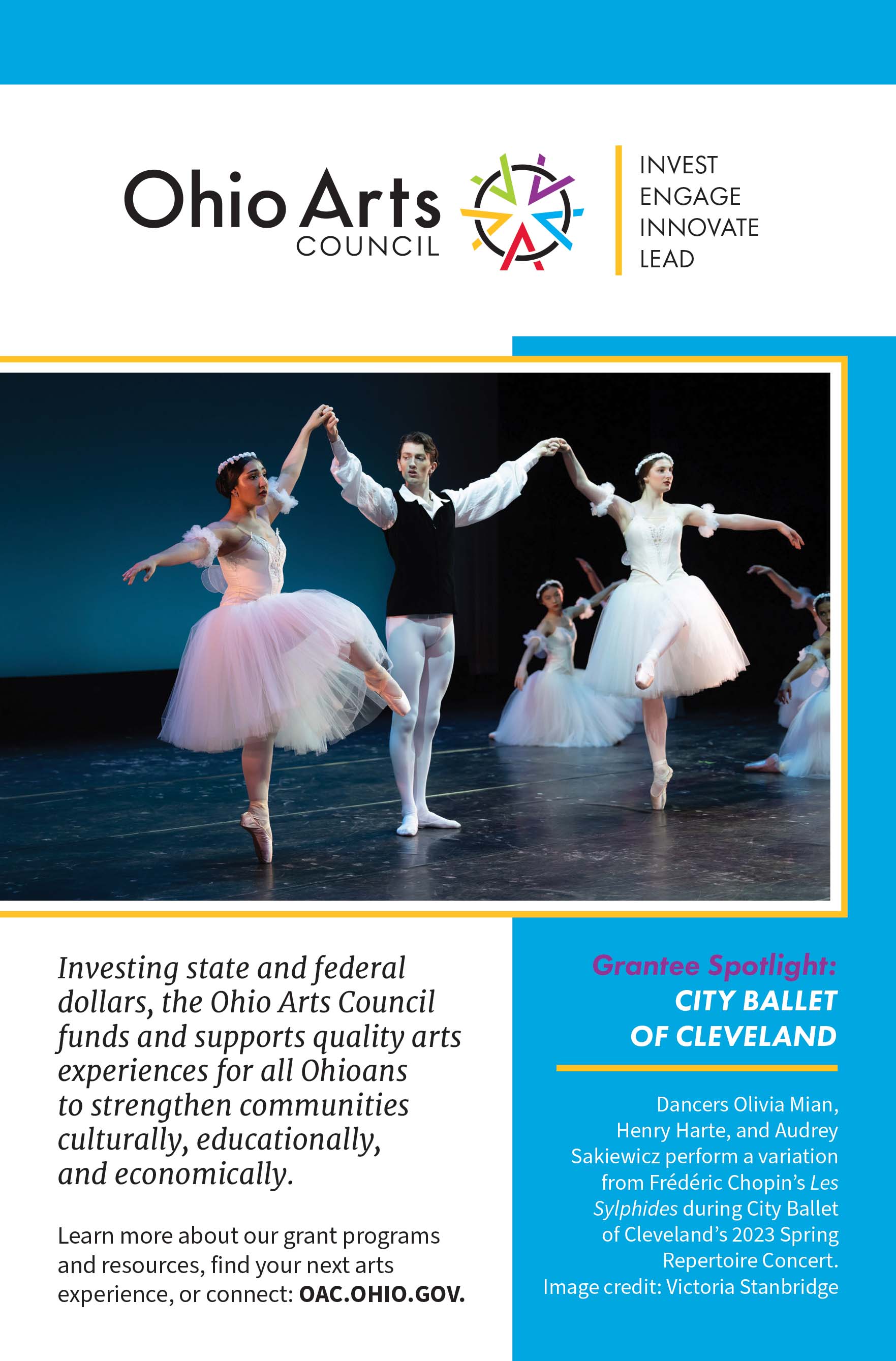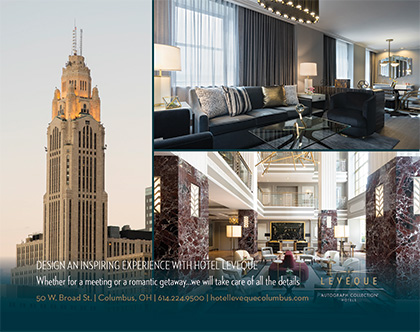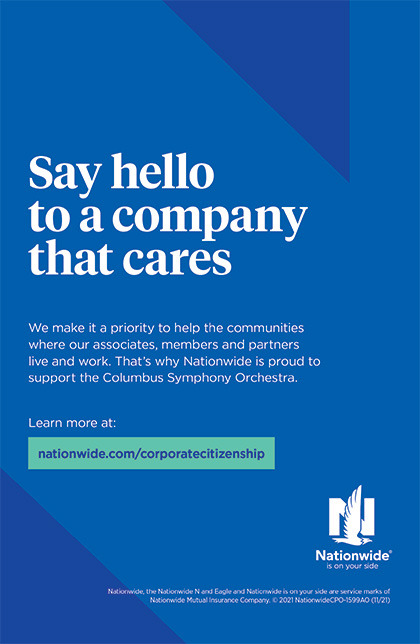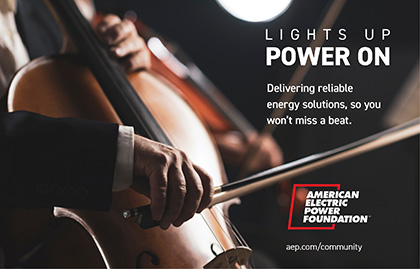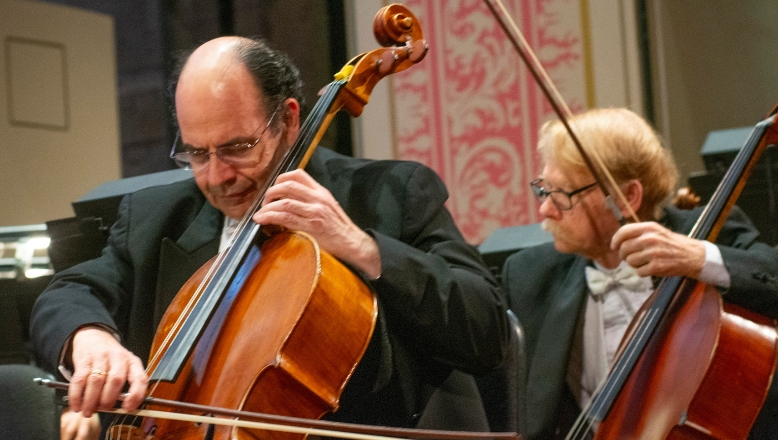

Friday, March 21, 2025, at 7:30PM
Saturday, March 22, 2025, at 7:30PM
Ohio Theatre
Boléro
MASTERWORKS 9
Rossen Milanov, conductor
Luis Biava, Cello
• • • • • • • • • • • • • • • • • • • • • • • • • • • • • •
PAUL HINDEMITH | Symphonic Metamorphosis of Themes by Weber | |
ERNEST BLOCH | Schelomo Luis Biava, cello | |
--INTERMISSION-- | ||
GEORGES BIZET | L’Arléseine Suite No 1. | |
MAURICE RAVEL | Boléro | |
Operating Support Generously Provided by


VIOLIN | BASS FLUTE |
Symphonic Metamorphosis on Themes of Carl Maria von Weber (1943)
by Paul Hindemith
(Hanau, nr. Frankfurt, 1895 - Frankfurt, 1963)
Paul Hindemith was one of the most versatile musicians of the 20th century. In addition to being an exceptionally prolific composer, he was one of the greatest violists of his time, and also performed on violin, piano, and clarinet. From 1940 to 1953, Hindemith lived in the United States, teaching at Yale University where he was an influential and successful as he had been in his native Germany. After 1953, he lived mostly in Switzerland, devoting more and more time to yet another type of activity, namely conducting.
Hindemith was, without a doubt, a “musician’s musician.” There is a sense of tactile joy inherent in his music which reflects his own virtuosity as a performer. As a result, one often experiences a certain visceral pleasure in playing as well as listening to his works. There are few subservient orchestral parts; each instrument contributes something significant. Hindemith believed, in fact, insisted that a composer should hear every note he or she intends to set down on paper, and that the audience should be able to hear every note written on the page.
Symphonic Metamorphosis is one of Hindemith’s most colorful orchestral scores. It grew out of an aborted ballet project Hindemith discussed with Russian-born dancer and choreographer Léonide Massine early in 1940. Massine had proposed to Hindemith a ballet based on music by Carl Maria von Weber (1786-1826), but the two men couldn’t agree on the details and had what one of Hindemith’s friends, Yale colleague and biographer Luther Noss called a “monumental falling out.” The ideas originally developed for the ballet had to be channeled into a concert piece, and Hindemith started thinking about a “Weber Suite” which eventually evolved into the four-movement Symphonic Metamorphosis. The work was given its premiere by Artur Rodzinski and the New York Philharmonic in 1944. It did eventually reach the ballet stage in 1952, with choreography by George Balanchine presented by the New York City Ballet.
Hindemith had taken thematic material from four different piano duets by Weber. For the second movement, he drew on Weber’s incidental music to Turandot, a work adapted into German by the great playwright Friedrich Schiller from an original by Carlo Gozzi. (Gozzi’s play also served as the basis of Puccini’s last opera, Turandot [1924]). Hindemith did not use the themes in the exact form in which he found them but made many chromatic changes; he added original harmonies and a colorful orchestration.
The opening march has a fanfare-like quality which prepares the listener for the arrival of the second movement, “Turandot,” which is in many ways is the centerpiece of the composition. It elaborates on a simple and very memorable pentatonic theme (one that could be played on the black keys of the piano), using the techniques of the passacaglia (variations over a bass) and fugue (with one voice imitating another according to a set of rules). The theme itself was one Weber had taken from Jean-Jacques Rousseau’s Dictionnaire de musique (1767), where it appeared as an example of Chinese music (one of the first such examples to be published in the West). In Hindemith’s hands, the simple theme “metamorphoses” into a complex and unconventional composition as the melody travels through the entire orchestra, (including even the timpani), showing off the attributes of each instrument in a most virtuosic way. The fugue starts midway through the movement with a section for brass scored in an unmistakable jazz style, its rhythm characterized by a swinging syncopation–a clear reflection of Hindemith’s American experience. The movement is reminiscent of a dream in which a brass band marches closer and closer, becoming wilder and more raucous. The band finally passes by, and the sound fades into the distance as the dreamer awakens to the light of reality with the final major chord.
Contrasting with the brash and brilliant second movement, the “Andantino” shows Hindemith’s lyrical and emotionally expressive side. At the end of this pastorale, a solo flute ornaments the final statement of the melody.
Just as the opening movement was a march, ushering us into the work, so is the last movement, and it serves as an exit–an epilogue that is also a commentary on the three previous movements. There are subtle reminiscences of what we have heard before, such as the use of dotted rhythms (long-short) from the first movement or triplets (beat divided into three instead of two) from “Turandot.” The triplets eventually become associated with a tune that sounds like an Irish jig. This tune comes to overpower the original melody completely, and ends the work with a musical exclamation point.
Schelomo: Hebrew Rhapsody for Violoncello and Orchestra
(1915-16)
by Ernest Bloch
(Geneva, Switzerland, 1880 –
Agate Beach, Oregon, 1959)
Schelomo is a passionate cry, deep from the heart of a man searching for his personal and artistic identity during a period of intense external and internal upheavals. Ernest Bloch, born in Switzerland and educated in Belgium and Germany, was struggling to find his place in the European musical world. Unable to secure a performance of his monumental Symphony in C-sharp minor in Paris, he also fell victim to theatrical intrigues at the Opéra-Comique, where his opera Macbeth had a much shorter run than originally planned. At home, he was passed over for the music directorship of the Suisse Romande orchestra (then known as the Geneva Symphony), in favor of Ernest Ansermet, who had earlier studied composition with Bloch. For a while, the composer had to work in his father’s clock business in Geneva (though he was at the same time a lecturer at the Conservatory there). It was around this time that Bloch first became conscious of his calling as a Jewish composer: he set himself the goal of expressing the Biblical heritage of his ancestors using a modern musical idiom influenced, among others, by Strauss and Debussy. While Bloch was grappling with these issues, World War I was raging in the countries of Europe; and although Bloch and his family were physically safe in neutral Switzerland, he couldn’t help but be deeply affected by the crisis that confronted him on all levels.
Bloch’s “Jewish cycle” of the years 1912-16 includes Three Jewish Poems for orchestra, the Israel Symphony, and Schelomo, the “Hebrew Rhapsody” for cello and orchestra that is to this day one of Bloch’s best-known works. The composer himself wrote at length about the genesis of Schelomo, explaining that he had been thinking, at first, of a vocal work based on the book of Ecclesiastes. The phrase “Vanity of vanities—all is vanity” seemed particularly appropriate to his pessimistic mood at the time. After meeting an excellent Russian cellist named Alexander Barjansky, Bloch changed his mind and decided to make the cello—“a voice vaster and deeper than any spoken language”—his protagonist. Barjansky’s wife, a sculptor, was concurrently working on a statue of King Solomon. Statue and composition were finished at the same time; and since Solomon is generally believed to be the author of Ecclesiastes, Bloch gave his work the title Schelomo—the Hebrew form of the name.
By dispensing with words, Bloch freed himself from the constraints of following a specific verbal program. Schelomo is a rhapsody in the true Romantic sense of the word. Traditional formal rules don’t apply; instead, the composition evolves in wholly unpredictable, quasi-improvisatory ways. The cello part moves from meditation and recitative to intense passion; the music reaches emotional climaxes only to collapse into the deepest despair in the next moment.
To Bloch, writing music of Jewish inspiration did not necessarily mean using melodies of Jewish origin. In this he differed from Stravinsky or Bartók, who turned to Russian or Hungarian folk sources to create music of Russian or Hungarian identity. He also differed from his contemporaries of the St. Petersburg school who collected Jewish folksongs and studied liturgical chant in order to find an authentic Jewish musical style. In contrast, Bloch’s approach was totally intuitive. He incorporated Jewish melodic fragments he had in his ear, making ample use of the augmented second, an interval frequently found in much Middle Eastern music. But he did not rely on traditional material, except in the central section of the work, where he quoted an ancient melody he had heard his father sing in Hebrew. This theme, first played by the oboe and the bassoon, is eventually taken over by the cello and the full orchestra.
After much emotional turmoil, Schelomo ends on a note of utter dejection, in keeping with the pessimistic philosophy expressed by Ecclesiastes: “all is vanity.” Bloch later wrote:
Almost all [my] works, however gloomy,....end with an optimistic conclusion or at least with hope. This [Schelomo] is the only one which ends....with an absolute negation. But the subject required it.
Bloch’s optimistic nature ultimately prevailed. A few months after completing Schelomo, he accepted an invitation to travel to the United States as touring conductor for the dancer Maud Allan. This turned out to be the beginning of a new life: before long, Bloch and his family moved to this country permanently. He finally enjoyed the success that had previously eluded him; both his European works and the new ones he was writing, were enthusiastically received. Schelomo was premiered at Carnegie Hall at an all-Bloch concert which one headline called the “Most Significant Event of the Year in New York.”
L’Arlésienne Suite No. 1 (1872)
by Georges Bizet
(Paris, 1838 - Bougival, 1875)
Alphonse Daudet’s play L’Arlésienne (“The Girl from Arles”), which opened in Paris on October 1, 1872 with incidental music by Georges Bizet, could be best described as a “folk tragedy.” During a time, when French cultural and artistic life was almost completely centered on the capital, Daudet gave voice to the Southern part of the country. Arles, where the title character of the play comes from, is just 20 miles from Daudet’s own birthplace of Nîmes. In the play, a young man in the countryside discovers that his fiancée is another man’s lover and takes his own life in despair.
Bizet’s musical contributions to the play tend to provide the Southern couleur locale, rather than attempt to illustrate the tragic plot. While the drama is largely forgotten today, the music is still popular in the form of the two suites, each in four movements, that were drawn from it. Bizet himself compiled the first suite the year of the premiere; a second suite was assembled, after the composer’s untimely death, by his friend, the composer Ernest Guiraud.
The Prelude to Suite No. 1 opens with the well-known melody of the “March of the Kings,” an old Provençal Christmas carol, which Bizet presents first in unison and then in a set of variations featuring different orchestral groups. The prelude also includes a slower section with a lyrical alto saxophone solo and an expansive melody led by the strings.
Movement 2 is a minuet along classical lines but with a special flavor; its central Trio section is essentially a waltz. Next comes an intensely melodious Adagio, scored for muted strings alone. The last movement is the famous “Carillon,” complete with a lyrical middle section in the rhythm of the siciliano dance.
Boléro (1928)
by Maurice Ravel
(Ciboure, Basses-Pyrénées, France,
1875 – Paris, 1937)
Ravel once described Boléro as “seventeen minutes of orchestral tissue without music.” Much to the composer’s surprise, Boléro eclipsed most of his other works in popularity. Ravel himself considered it “an experiment in a very special and limited direction that should not be suspected of aiming at achieving anything different from, or anything more than, it actually does achieve.”
What it does achieve, then, is a single long-drawn-out crescendo in which the instruments of the orchestra enter gradually to build up to the final climax. The melody, which is quite complex, with many irregularities in its phrase structure, never changes. More precisely, it alternates between two forms, one beginning with the note C, the other with B-flat. Generally, we hear the “C” version twice, followed by two renditions of the “B-flat” version, and then the “C” form again. The snare drums play the bolero rhythm without a moment’s interruption from beginning to end. The bass part is not exceedingly varied either: it consists of only two notes, C and G, for about sixteen and a half minutes out of seventeen. It therefore comes as a great surprise when, just before the end, the bass suddenly changes from C-G to E-B for exactly eight measures. C and G then return to close the piece.
Boléro was first conceived as a ballet for Ida Rubinstein’s dance company in Paris. (Interestingly, the original title was Fandango, another Spanish dance, which has a slower tempo; Ravel always insisted that the tempo of his piece should not be rushed.) The original ballet’s storyline, if it may be called that, is as follows:
The curtain rises on a dark, smoky room in a Spanish tavern. A woman enters, dressed as a gypsy, with a tall Spanish comb and a scarlet and black shawl. Atop a table, she begins to stamp out the rhythm of the bolero. Instantly the room fills with men. The music grows in passion and the woman is joined in the dance, first by one and then by a dozen or so men. The excitement increases. Knives are drawn. A fight is barely avoided. The gypsy woman is tossed from arm to arm. Then, suddenly, all comes to a stop as the music reaches its climax. Curtain.
Notes by Peter Laki
